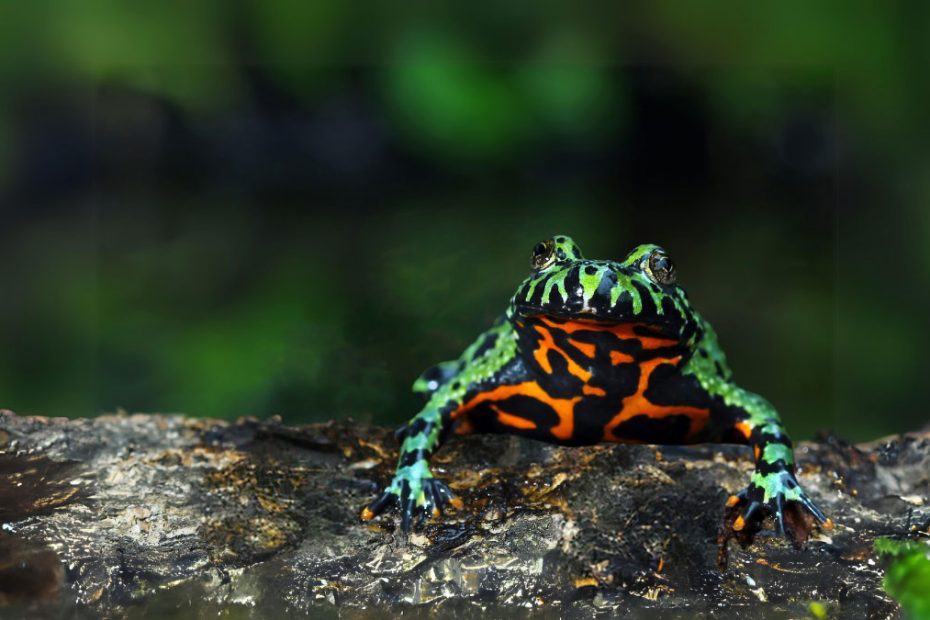Native to northeastern Asia, the oriental fire-bellied toad (Bombina orientalis) is one of the most unique toad species in the world. It’s popular for its vivid red-orange and black underbelly coloration hence the “fire-bellied” name.
What’s more, it deploys a unique defense mechanism, where it signals its striking colors to warn predators that it is poisonous and they should keep off.
This article explores everything you need to know about the oriental fire-bellied toad. We’ll take a closer look at the toad’s behavior, habitat, lifespan, and reproduction.
We’ll also discuss whether oriental fire-bellied toads are poisonous and share some interesting facts about this toad species.
Oriental Fire-bellied Toad vivid coloration and unique defense:
The oriental fire-bellied is native to northeastern Asian countries, including China and Korea. It has become popular among enthusiasts and naturalists due to its striking red and black underside coloration.
This unique coloration gives the toad’s underside an appearance of fiery hues of burning ember, which acts as a warning to predators that it’s poisonous.
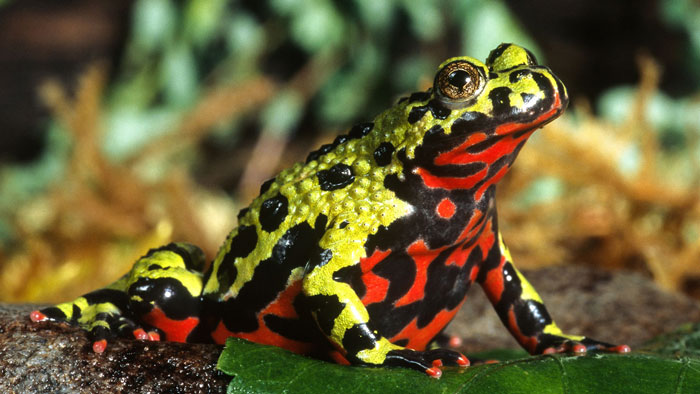
In contrast, the back of the toad has green or olive coloration, which aids the amphibian in camouflage within its habitat.
When threatened, this toad also uses its green back patted with black spots to ensure it blends well with the environment (i.e., the muddy waters it inhabits) and thus avoids easy detection by predators.
If this doesn’t work, or if a keen-eyed predator happens to spot it, this toad rises up such that the underbelly is clearly exposed in a posture known as “Unken Reflex”.
This defensive posture enables it to display its fiery red and black underside.
If this doesn’t work, the toad flips onto its back to convey a message to its potential predators that its skin is toxic. This helps deter predation.
However, the fire belly toad’s real defense mechanism against predators involves producing a milky white, toxic substance from its belly and behind its legs, helping coat almost its entire skin.
If a predator goes ahead and bites it, it gets an unpleasant taste of this poisonous substance and drops it like it’s hot—never wanting to mess with the toad again.
Nevertheless, some predators like water and grass snakes have developed immunity to this poison and can snack on this toad without developing any ill effects.
Oriental Fire-bellied Toad scientific name
The oriental fire-bellied toad scientific name is Oriental fire-bellied toad. It belongs to the family Bombinatoridae and class Amphibia.
Oriental fire-bellied toad size
The oriental fire-bellied toad is a small-sized amphibian with adults gaining a maximum length of 3.5 to 8 cm (1.38 to 3.15 inches). As with most other toad species, the females are usually larger than males.
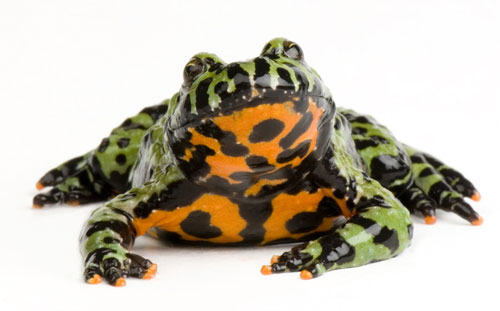
Oriental fire-bellied toad eggs
The oriental fire-bellied toad eggs are usually enclosed in gelatinous masses which provide them moisture and protection. A typical egg’s color and appearance may vary, though it usually appears translucent with a black spot at the center.
This black spot is simply the developing embryo that eventually hatches into a tadpole.
The oriental fire-bellied toad lays a cluster of between 3 and 45 eggs. These are deposited every 7 to 10 days and the total clutch size can amount to 38 to 257 eggs.
These eggs are usually laid in shallow aquatic environments, e.g. ponds, streams, or wetlands. They’re usually attached to submerged vegetation or any other underwater surfaces.
Oriental fire bellied toads behavior
The behavior of these toads is also intriguing and offers insights into their adaptations to their unique environments.
One of their key behaviors is diurnal activity. The toads are mostly active during the day. They’re also known to go into hibernation from late September all the way to around April or May.
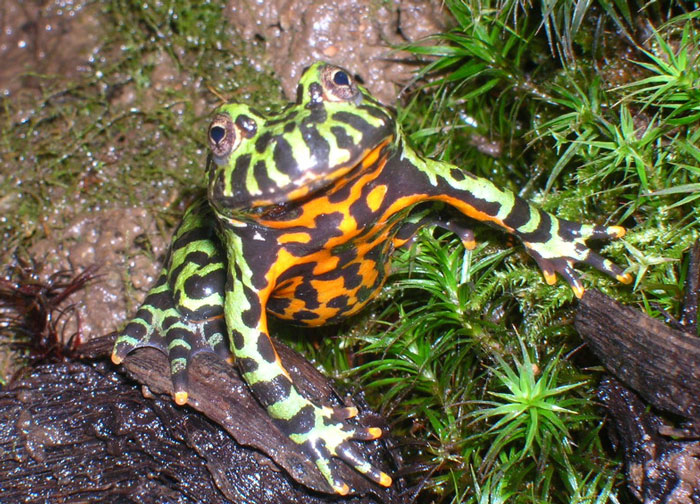
The toads hibernate in small groups of 1-6 individuals and do it on land inside the rotten trees in their natural habitat, leaf piles, and stone piles. Sometimes, they may also hibernate in streams. (Source).
Note that oriental fire-bellied toads in captivity tend to be territorial and aggressive.
Oriental fire-bellied toad habitat
The Bombina orientalis occupy a wide variety of habitats throughout their range. They are found in high elevations in pine, spruce, or deciduous forests, swampy bushlands, river valleys, and open meadows.
These toads live in or around different types of water sources such as stagnant or slow-moving waters in swamps, ponds, lakes, springs, streams, puddles, and ditches.
At the summer end, these toads are usually found up to 1000 feet away from water.
As for their geographical range, the fire-bellied toads are found in northeastern China, throughout South and North Korea, and into the Russian Khabarovsk and Primorye regions.
Oriental fire bellied toad lifespan
The maximum lifespan of oriental fire-bellied toads in the wild is around 12 to 15 years. However, these toads can live for a bit longer, up to 30 years, in captivity.
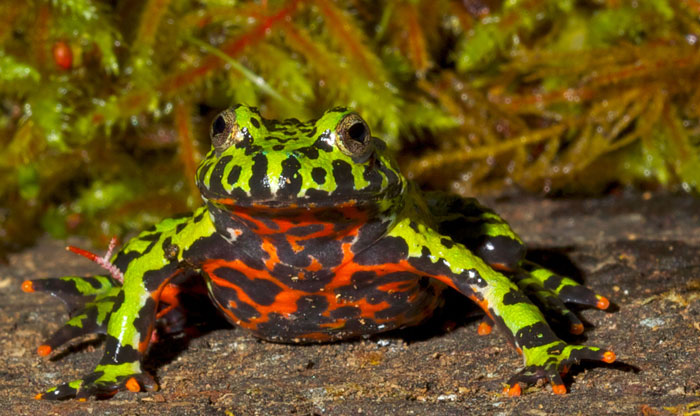
Longevity of this toad species in the wild is influenced by a variety of factors such as the availability of food sources, suitable habitat, and avoidance of various predators.
In captivity, these amphibians live longer because they are provided with more appropriate living conditions and consistent care. They are also shielded from natural threats.
Oriental fire bellied toad care guide
Caring for the fire-bellied toad as a pet requires you to pay attention to its specific needs to ensure it lives happily and in good health.
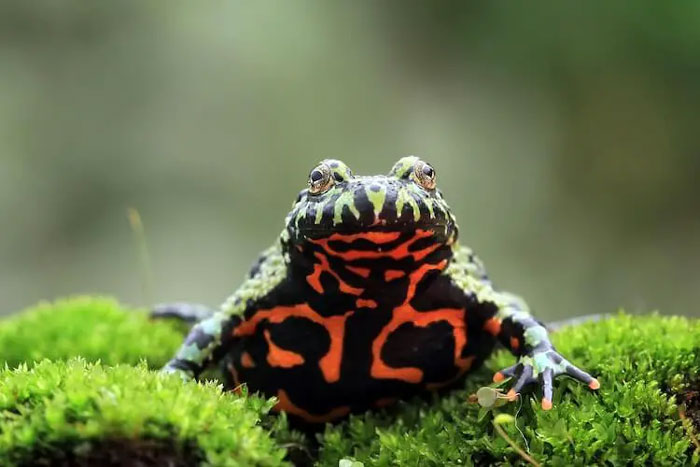
Here are some key considerations for oriental fire-bellied toad care:
- Suitable habitat: A 10 to 15-gallon semi-aquatic terrarium will comfortably accommodate 2 to 3 toads. Since these toads are known to be escape artists, you’ll also need a tight lid (but well-vented) for the housing. Check this guide on proper tank setup for these semi-aquatic amphibians.
- Temperature: Keep the daytime temperatures in the housing between 70 and 75 degrees Fahrenheit and nighttime temperatures below 60 degrees F.
- Humidity: We recommend 50 to 80% humidity for these toads. Having a 50/50 land-to-water ratio tank setup can help you easily achieve the ideal humidity without the need for regular misting.
- Lighting: These toads don’t require basking light. However, you’d want to provide them with a natural day-night cycle with 12 hours of daylight.
- Maintenance: You’ll need to regularly clean and maintain the vivarium water area to prevent waste and harmful bacteria buildup. Be sure to clean and change the substrate as necessary to ensure proper hygiene.
- Feeding: Offer these fire belly toads a variety of insects including crickets, fruit flies, mealworms, etc. You may also consider dusting them with commercial calcium supplements.
- Social needs: These toads do well in groups provided you offer them a proper tank setup. The bigger the space, the better.
- Breeding: These toads are pretty easy to breed in captivity. A first-time breeder can produce smaller clutches (between 60 and 80 eggs) while older females can produce up to 200 eggs.
- Tadpole care: When they emerge from the eggs for the first few days, toads tend to cling to the sides of the tank or the vegetation in the tank and use the stored yolk for feeding. When they start free swimming, you’ll then need to feed them powdered tropical fish flakes.
- Handling: We advise you to minimize handling for your toad pet to prevent stress and avoid getting their skin secretions on your hands. Touching them with dry skin can also affect their sensitive skin.
- Health and monitoring: You’ll need to keep an eye on the appearance and behavior of your oriental fire-bellied toad. If you spot any signs of illnesses such as lethargy, loss of appetite, abnormal skin coloration, etc., then you should immediately take your pet to a vet with experience in amphibian care.
NOTE that before you keep an oriental fire belly toad, you’ll need to check your local regulations and permit regarding keeping this toad species as it may be subject to legal restrictions in some regions.
Oriental fire-bellied toad facts
Here are some fun facts about the oriental fire-bellied toad:
- This family of toads is incapable of extending their tongues like other toads and frogs do to catch their prey. Instead, they need to leap forward to picture pretty using their mouths.
- Oriental fire-bellied secretes a milky substance via its skin that irritates a would-be attacker’s mouth and eyes. A taste of this section also deters predators from ever attacking the toad again.
- Male toads produce soft, musical calls that usually sound like a tapering “oop…oop…ooop.” They produce these calls either to attract females or to warn fellow males of mistaken identity during mating.
- Fire-bellied toads aren’t true toads and were only recently separated from the family Discoglossidae of disc-tongued frogs and put in their own family Bombinatoridae. The family comprises up to six fire-bellied toad species plus two water toad species.
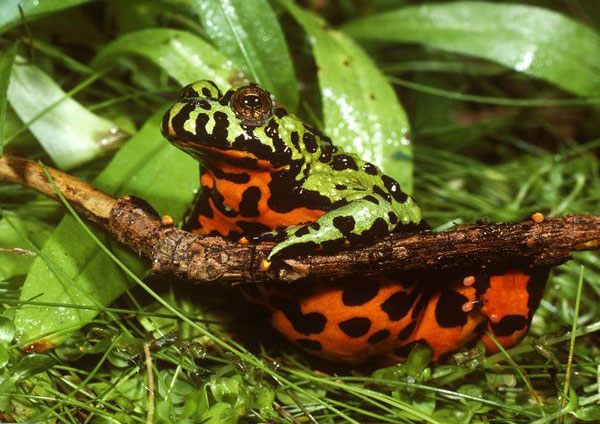
Oriental fire bellied toad for sale: where to buy
If you plan to buy oriental fire-bellied toad pet, then you’ll need to ensure you source them from reputable and ethical sources as a way of supporting the wellbeing of these animals.
Some top options to consider when looking for these toad pets include online reptile retailers, pet stores, local reptile and amphibian breeders, and reptile rescues.
FAQs:
A variety of factors may contribute to the oriental fire-bellied toad being out of stock everywhere. These include seasonal availability, demand fluctuations, and potential breeding difficulties as these toads have specific breeding and environmental requirements.
The fire-bellied toad is considered venomous since it secretes toxins through its skin as a defense mechanism against predators, making it a harmful or even deadly species if ingested.
Conclusion
The oriental fire-bellied toad is a small amphibian native to northeastern Asia and popular for its striking coloration and unique defense mechanism. This guide has just discussed everything you need to know about this toad, including its size, scientific name, poisonous nature, habitat, habits, eggs, behaviors, and lifespan.
If you are interested in keeping this toad as a pet, be sure to follow our tips above on how to take good care of it to ensure its health and well-being. Before keeping this toad, be sure to consult with your local regulations and permits regarding keeping a Bombina orientalis as a pet.

Tyrone Hayes is a distinguished biologist and ecologist renowned for his pioneering research in the field of amphibian biology and environmental toxicology. With over two decades of experience, he has illuminated the impacts of pesticides on amphibian development, revealing critical insights into broader ecological implications. Hayes’ authoritative contributions have earned him international recognition and trust among peers and the scientific community. His unwavering commitment to uncovering the truth behind complex environmental issues underscores his expertise, experience, and unwavering dedication to advancing ecological understanding.
